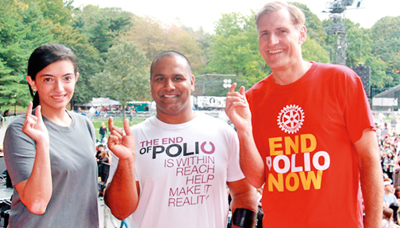The end of Polio, near – and yet so far!
In the late 1950s the world witnessed one of the miracles of modern medicine when Dr. Albert Sabin announced a powerful new vaccine that promised to rid the world of the scourge of polio — a disease which terrorized parents everywhere, regardless of colour, creed, or socioeconomic standing.
Twenty-five years later, polio had disappeared from the industrialized world, but like so many of the miracles of modern science, the promise of Dr. Sabin’s vaccine went largely unrealized for the majority of humanity — those who lived in the world’s poorest countries.

Aseefa Bhutto Zardari, Canadian Rotarian Ramesh Ferris, and RI General Secretary John Hewko make the “This Close” sign before the concert begins. Photo by Marga Hewko
In 1985, a small group of people was determined that this injustice should be rectified, that children everywhere might no longer live under the spectre of polio. This group included Dr. Sabin himself, Dr. Carlyle de Macedo, the head of WHO’s Pan-American Health Organization; and Dr. Carlos Canseco, the President of Rotary International.
What began as a dream in 1985, has grown into the largest international health initiative ever — a partnership led by Rotary International which included the World Health Organization, UNICEF, and the U.S. Centers for Disease Control and Prevention and which now has the support of the Bill & Melinda Gates Foundation and the United Nations Foundation.
Apart from their fundraising and ground support, Rotary advocacy has been instrumental in bringing political leaders from virtually every country to play an active role — from the President of China Jiang Zemin to South African statesman Nelson Mandela.
Eradication of a disease like Polio does not happen overnight. The ultimate challenge in the global eradication initiative was sustaining the interest, effort and enthusiasm till the job was done – over a period of almost 24 years.During this period, Rotary led efforts ensured vaccination of every child everywhere with the oral polio vaccine. From Rotary’s point of view it has proven that its 1.2 million Rotarians in 34,000 Rotary clubs in 180 countries can achieve as much as Governments can, if they set their mind to it.
Rotary and its (Global Polio Eradication Initiative (GPEI) partners reached more than 2.5 billion children with the oral polio vaccine. Polio cases have plummeted by more than 99 percent since 1988, when the disease infected about 350,000 children a year and with India being polio free for over a year now the battle appears to be nearing its end with the virus continuing to be active only in three countries –Nigeria, Pakistan and Afghanistan.
Although these are the only three endemic countries (where polio has never been eradicated) countries which were previously cleared can also be re-infected as we saw in recent outbreaks in China, the Congo, and Tajikistan. It must be remembered that if eradication fails and polio rebounds, up to 200,000 children a year could be paralyzed.
Last month Rotary International has made a new funding commitment of US$75 million over three years to the GPEI. Rotary, which has already contributed nearly US $1.2 billion (including over US$5m to Sri Lanka) to the GPEI, announced the commitment at a September 27 high-level side event on polio eradication, convened by United Nations Secretary-General Ban Ki-moon during the United Nations General Assembly in New York. Present were the heads of Nigeria, Pakistan and Afghanistan, the three remaining endemic countries.
The Islamic Development Bank (IDB), a new donor to the polio eradication effort, announced a US$227 million loan to Pakistan and a US $3 million grant for polio activities in Afghanistan.
The UN Secretary General urged UN member states to ramp up their support for the GPEI, launched in 1988 by Rotary
Rotary’s chief responsibilities in the initiative are fundraising and advocacy, an increasingly important role as the polio end game draws near.
Earlier this month, Rotary launched a new website to garner greater support for the global polio eradication effort. More than 6,000 visitors signed a petition on the site calling for world leaders to commit additional resources to close the funding gap. The petition was presented at the UN polio eradication side event.
Visitors to the site can also estimate the potential dollar value they can generate by sharing the polio eradication message through Facebook, Twitter, and other social media.
Last week Rotary International shared the polio eradication message with the world during a massive charity concert Global Citizen Festival 2012 in New York’s Central Park where the Foo Fighters, The Black Keys, and Neil Young with Crazy Horse, drew a live audience of more than 60,000, and many more online and via television broadcasts.
Present at the event was Aseefa Bhutto Zardari, daughter of Pakistan President Asif Ali Zardari and Rotary International General Secretary John Hewko both stirring up the crowd to help eradicate the disease.
Thanks to Rotary leadership the end of Polio is near.
(The writer is a past Rotary International Director)
Follow @timesonlinelk
comments powered by Disqus























